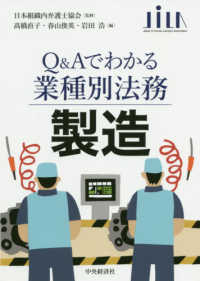- ホーム
- > 洋書
- > 英文書
- > Science / Mathematics
Full Description
Electric dipole moments (EDMs) have interested physicists since 1950, when it was first suggested that there was no experimental evidence that nuclear forces are symmetric under parity (P) transformation. This question was regarded as speculative because the existence of an EDM, in addition to P violation, requires a violation of time-reversal (T) symmetry. In 1964 it was discovered that the invariance under CP transformation, which combines charge conjugation (C) with parity, is violated in K-meson decays. This provided a new incentive for EDM searches. Since the combined operations of CPT are expected to leave a system invariant, breakdown of CP invariance should be accompanied by a violation of time-reversal symmetry. Thus there is a reason to expect that EDMs should exist at some level. The original neutron EDM experiments were later supplemented with checks of T invariance in atoms and molecules. These investigations are pursued now by many groups. Over the years, the upper limit on the neutron EDM has been improved by seven orders of magnitude, and the upper limit on the electron EDM obtained in atomic experiments is even more strict.
Contents
1. Introduction.- 1.1 Overview of CP Violation Without Strangeness.- 1.2 The Neutron Electric Dipole Moment: Early History.- 1.3 Molecular Electric Dipole Moments and CP Violation.- 1.4 T-Odd Effects Without CP Violation.- 2. Kinematics of Discrete Symmetries.- 2.1 CPT Theorem: Intuitive Approach.- 2.2 T-Even and T-Odd Electromagnetic Multipole Moments.- 2.3 General Structure of Four-Fermion Operators.- 3. General Features of EDM Experiments.- 3.1 Interaction of an EDM with an Electric Field.- 3.2 Ground State Optical Pumping and Detection of Atomic Polarization.- 3.3 Electric Fields and Coherence Times in Various Systems.- 3.4 Magnetic Field Control and Generation.- 3.5 Systematic Effects.- 4. The Search for the Neutron EDM.- 4.1 Properties of the Neutron.- 4.2 Interaction of Neutrons with Matter.- 4.3 Neutron Beam EDM Experiments.- 4.4 Ultracold Neutrons.- 4.5 Neutron EDM Measurements with Stored Ultracold Neutrons.- 4.6 The Future: Superfluid He Neutron EDM with a 3He Comagnetometer.- 4.7 Comparison of Experimental Techniques.- 5. Theoretical Predictions for Neutron and Electron Dipole Moments.- 5.1 The CP-Violating ? Term in Quantum Chromodynamics.- 5.2 Predictions of the Standard Model for Dipole Moments.- 5.3 Spontaneous CP Violation in the Higgs Sector.- 5.4 Phenomenological Approach.- 6. EDM Experiments with Paramagnetic Atoms.- 6.1 The Shielding Problem.- 6.2 Enhancement of the Electron EDM in Paramagnetic Atoms.- 6.3 Overview of Paramagnetic Atom Experiments.- 6.4 The Cs EDM Experiment.- 6.5 The T1 EDM Experiment.- 6.6 Future Prospects for Improving the Electron EDM Limit.- 6.7 EDM Limits of Some Other Elementary Particles.- 7. EDM Experiments with Diamagnetic Atoms.- 7.1 Shielding in the 1S0 System.- 7.2 The 129Xe EDM Experiment.- 7.3 The 199Hg EDMExperiment.- 7.4 3He — 129Xe Comparison.- 8. Atomic Calculations.- 8.1 Wave Function of an Outer Electron at Short Distances.- 8.2 The Electron EDM in Paramagnetic Heavy Atoms.- 8.3 CP-Odd Electron—Nucleon Interaction.- 8.4 Electron EDM in Diamagnetic Atoms.- 8.5 CP-Odd Nuclear Moments.- 9. T Violation in Molecules.- 9.1 Enhancement of an Applied Field by a Polar Molecule.- 9.2 TIF Beam Experiments.- 9.3 What Have We Learned from the TIF Experiment?.- 9.4 Paramagnetic Molecules.- 9.5 What Will Be Gained from Experiments with Paramagnetic Molecules?.- 10. CP-Odd Nuclear Forces.- 10.1 CP-Odd Mixing of Opposite-Parity Nuclear Levels.- 10.2 Nuclear Moments Induced by T- and P-Odd Potentials.- 10.3 Enhancement Mechanisms for T- and P-Odd Nuclear Multipoles.- 10.4 Theoretical Predictions and Implications.- 11. What Do We Really Know About T -Odd, but P-Even Interactions?.- 11.1 Long-Range Effects.- 11.2 TOPE Fermion—Fermion Interactions.One-Loop Approach.- 11.3 TOPE Fermion—Fermion Interactions.Two-Loop Approach.- 11.4 Conclusions on TOPE eN and NN Interactions.- 11.5 T-Odd ? Decay Constants.- References.








